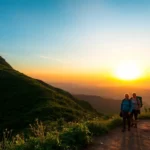Introduction to Trekking in Indonesia
Indonesia, a sprawling archipelago comprising over 17,000 islands, is renowned for its rich natural diversity, breathtaking landscapes, and vibrant cultures. This extraordinary environment makes it a prime destination for outdoor adventurers, particularly those seeking the thrill of trekking. Trekking in Indonesia offers an immersive experience through lush rainforests, volcanic landscapes, coastal trails, and remote villages, allowing explorers to connect deeply with nature and local traditions. Whether you’re a seasoned trekker or a beginner, Indonesia’s varied terrains provide a multitude of routes suitable for all levels, making it an ideal playground for adventure tourism.
What Makes Indonesia a Prime Trekking Destination?
The appeal of Indonesia as a trekking hub lies in its unparalleled natural variety and cultural richness. The country is home to several active and dormant volcanoes, pristine jungles, and endemic species that thrive in untouched habitats. These unique environments attract trekkers from around the globe seeking challenging climbs, scenic hikes, and authentic encounters with local communities. For instance, Mount Rinjani in Lombok stands as Indonesia’s second highest volcano, offering a demanding but rewarding multi-day trek with stunning crater lakes and panoramic views. Similarly, the forests of Borneo and Sumatra host exotic wildlife such as orangutans and pygmy elephants, attracting eco-enthusiasts.
Beyond its landscapes, Indonesia’s cultural tapestry—traditional villages, indigenous tribes, and vibrant festivals—adds depth to trekking journeys, transforming a simple hike into an unforgettable adventure. With well-established infrastructure in popular spots and emerging routes in less explored regions, Indonesia continues to grow as a top trekking destination.
Types of Trekking Experiences Available
When exploring Indonesia’s vast terrains, trekkers can choose from a wide array of experiences tailored to their interests and skill levels:
- Volcano Trekking: Climbing active and dormant volcanoes like Rinjani, Kelimutu, and Kerinci, often involving multi-day ascents with campings overnight in mountain shelters.
- Jungle Trekking: Navigating dense rainforests in Borneo or Sumatra, often combining wildlife observation with crossing rivers, climbing over fallen logs, and discovering hidden waterfalls.
- Mountain Passes and Ridge Walks: Traversing high-altitude ridges and mountain terrains such as the Dieng Plateau or the Ijen Crater, offering spectacular vistas and challenging climbs.
- Cultural Treks: Visiting remote villages, interacting with indigenous tribes like the Mentawai or Dayak, and experiencing local traditions firsthand.
- Off-the-Beaten-Path Trails: Exploring lesser-known trails in regions such as West Papua or the Nusa Tenggara islands, perfect for those seeking solitude and unique landscapes.
Each type of trekking provides unique challenges and rewards, emphasizing the importance of selecting routes that match your physical condition, time availability, and adventure goals.
Understanding the Basic Concepts of Trekking
Trekking, distinct from casual hiking, involves prolonged outdoor walking, often over multiple days, through rugged and diverse terrains. It usually requires broader planning, including route selection, accommodation arrangements, and logistical considerations. In essence, trekking combines elements of endurance, navigation, and sometimes camping, into a comprehensive outdoor adventure.
Unlike recreational hiking, which generally covers shorter distances on established trails, trekking might involve exploring wilderness areas with limited access and few amenities. It demands a solid understanding of terrain, weather conditions, and physical preparedness. The activity is characterized by the pursuit of discovering remote landscapes, often in challenging environments, thus requiring both physical fitness and mental resilience.
While hiking can be a day activity with leisurely pursuits, trekking usually extends across days, weeks, or even months, with the goal of immersing oneself into the natural and cultural fabric of a region. This depth of experience makes trekking a profound adventure for those eager to push their boundaries and deepen their appreciation of nature.
Preparing for Your Trekking Adventure
Essential Gear and Equipment for Trekking in Indonesia
Proper preparation begins with assembling the right equipment tailored to Indonesia’s diverse climates and terrains. Key items include:
- Footwear: Durable, waterproof trekking boots with ankle support are essential for rugged terrains and volcanic ash or muddy paths.
- Clothing: Moisture-wicking layers, thermal wear for cooler nights, and a lightweight rain jacket. In tropical regions, quick-dry shirts and hats for sun protection are advisable.
- Navigation Tools: GPS devices, traditional maps, and a compass, especially for off-the-beaten-path routes where signage may be sparse.
- Sleep System: Lightweight tents or hammocks, sleeping bags suited for temperature ranges, and sleeping mats for comfort and insulation.
- Safety Gear: First aid kits, multi-tools, headlamps, and emergency communication devices for remote areas.
- Miscellaneous: Sufficient water bottles, water purification tablets, high-energy snacks, insect repellent, and sunscreens.
Physical and Mental Preparation Tips
To ensure a safe and enjoyable trek, building physical stamina before departure is crucial. Engage in cardiovascular exercises like hiking, running, or cycling, complemented by strength training focusing on legs, core, and balance. Gradually increasing travel distances and elevation gains helps simulate trekking conditions and boosts endurance.
Mental preparedness involves cultivating resilience to face unpredictable elements such as weather changes, difficult terrains, and potential delays. Practicing mindfulness, setting realistic expectations, and familiarizing oneself with the route through maps or reconnaissance can reduce anxiety and enhance decision-making during the trek.
Nutrition also plays a vital role; maintaining a balanced diet leading up to the trip enhances overall stamina and recovery.
Planning Your Route and Duration Effectively
Effective route planning involves researching suitable trails, understanding terrain difficulty, and factoring in timing for acclimatization and rest. Consulting local guides or experienced trekking agencies can provide invaluable insights and logistical support. Tools such as topographical maps, trail guides, and online forums help identify routes aligned with your skill level and interests.
Determining the duration depends on your fitness, experience, and goals. For multi-day treks, allocating sufficient days with buffer time for rest and contingency plans is wise. In Indonesia, popular routes like Mount Rinjani typically require 2-3 days, while remote jungle expeditions can span a week or more. Comprehensive planning enhances safety, comfort, and overall satisfaction.
Popular Trekking Routes in Indonesia
Mount Rinjani: The Majestic Volcano Trek
Mount Rinjani, towering at 3,726 meters, is Indonesia’s second-highest volcano and an iconic trekking destination. The Rinjani Trek is renowned for its challenging ascent, scenic crater lakes such as Segara Anak, and geothermal landscapes. The typical route from Senaru or Sembalun involves a 2-4 day journey, with options to customize based on trekking experience.
Trekkers are rewarded with stunning views of the surrounding islands, panoramic vistas from the summit, and the chance to immerse in the local Sasak culture. The trek requires physical preparation due to high altitude and unpredictable weather, but the awe-inspiring scenery and sense of achievement make it worthwhile.
Jungle Treks in Borneo and Sumatra
Borneo and Sumatra boast extensive rainforests, rich biodiversity, and indigenous cultures. Jungle treks in these regions involve navigating challenging terrain, crossing rivers, and observing rare wildlife like orangutans and pygmy elephants. Such expeditions often include visits to conservation centers and remote villages, offering eco-tourism experiences with a focus on sustainability.
These treks can be tailored from a few days to multi-week adventures, emphasizing nature observation, bird watching, and interacting with local tribes who maintain traditional lifestyles. Preparation includes learning about wildlife safety, proper gear, and environmental conservation practices.
Hidden Trails and Off-the-Beaten-Path Trekkings
For seasoned trekkers seeking solitude and unique landscapes, Indonesia offers lesser-known routes in areas like West Papua, the Nusa Tenggara islands, and Sulawesi. These trails often involve minimal infrastructure, requiring self-sufficiency and advanced planning. They encompass remote coastal hikes, mountain summits, and cultural exploration.
Such experiences demand thorough preparation, local guides, and respect for indigenous territories. They provide unparalleled opportunities to discover untouched ecosystems and authentic local cultures away from crowded tourist spots.
Safety Tips and Best Practices During Trekking
Health and Safety Precautions
Safety is paramount in trekking adventures. Always inform someone about your itinerary and expected return. Carry a comprehensive first aid kit and basic medications. Hydrate regularly, and be cautious of signs of altitude sickness or heat exhaustion, especially at higher elevations or during tropical heat.
Be mindful of terrain-specific risks—loose volcanic ash, slippery rocks, or dense vegetation—and adopt proper trekking techniques. If uncertain, consult local guides or authorities for current trail conditions and weather updates.
Respecting Nature and Local Cultures
Responsible trekking involves minimizing environmental impact. Follow Leave No Trace principles: dispose of waste properly, avoid damaging flora and fauna, and stay on established trails. Engage with local communities respectfully—learn about customs, seek permission when visiting villages, and support local economy through responsible tourism.
Cultural sensitivity and environmental stewardship ensure the preservation of Indonesia’s natural and cultural heritage for future generations.
Emergency Response and Support
Preparation for emergencies includes having access to communication devices such as satellite phones or local SIM cards, understanding basic survival skills, and knowing the location of nearby medical facilities. Trekking with trained guides increases safety, as they are familiar with terrain and can provide assistance or evacuation if needed.
Always carry a contingency plan, sufficient supplies, and be adaptable to changing conditions to ensure a secure and enjoyable adventure.
Maximizing Your Trekking Experience
Capturing Memories and Nature Photography
Documenting your journey through photography enriches the adventure and creates lasting memories. Indonesia’s landscapes—volcanoes, waterfalls, wildlife—offer countless photo opportunities. Invest in a good camera or Smartphone with protective gear, and learn basic photography techniques like framing and lighting.
Dawn and dusk are optimal times for lighting, while macro shots capture intricate details of flora and fauna. Respect nature when photographing, avoiding disturbance to wildlife and ecosystems.
Incorporating Sustainable and Responsible Trekking
Sustainability enhances the health of Indonesia’s ecosystems and communities. Follow eco-friendly practices: carry reusable water bottles, reduce plastic usage, and opt for eco-lodges or homestays supporting local initiatives. Support locally-run guiding services and purchase handmade crafts as authentic souvenirs.
Educate yourself on the cultural significance of sites visited and avoid activities that could harm local traditions or environments. Being a responsible trekker ensures the longevity and beauty of Indonesia’s natural treasures.
Post-Trek Recovery and Reflection
After the physical exertion of trekking, prioritize recovery—stretching, hydration, nutritious food, and adequate rest. Reflect on experiences gained, new skills acquired, and cultural insights. Share your stories and promote awareness about Indonesia’s natural beauty and conservation needs.
Taking time for reflection enhances personal growth and prepares you for future adventures, turning trekking into a meaningful lifelong pursuit rather than just a physical activity.









